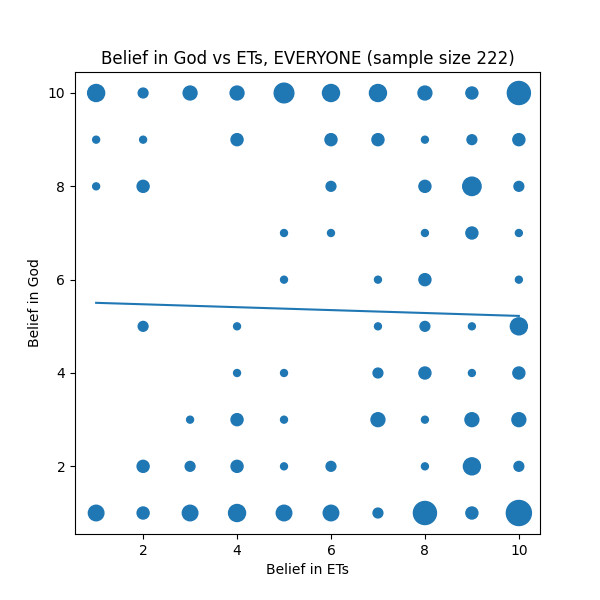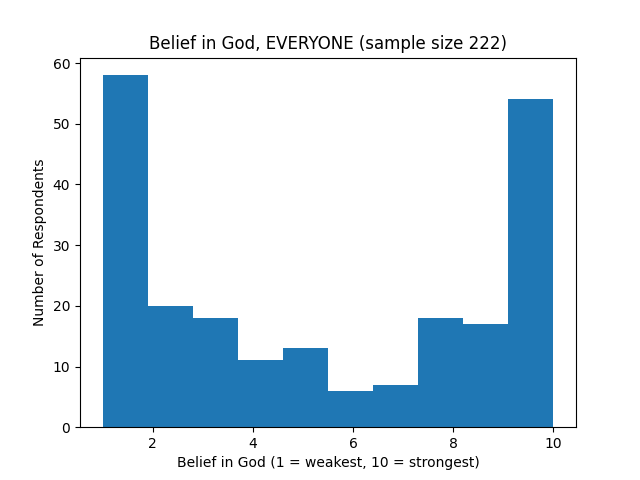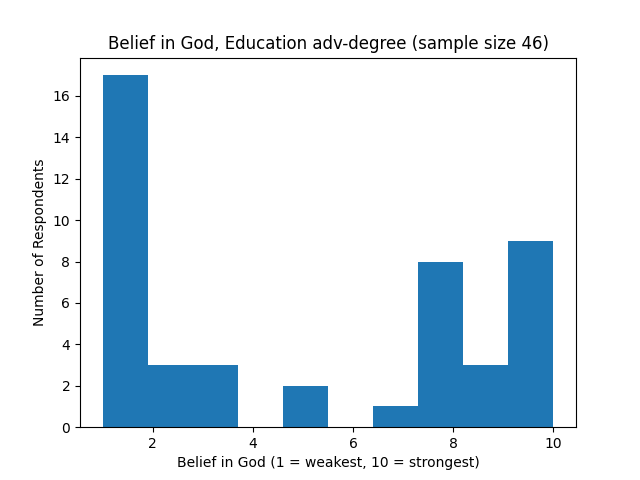Introduction and Context
In June 2023, I had the pleasure of joining UATX for its Forbidden Courses1. I took the Science and Christianity Seminar, led by Prof. Dorian Abbot from the University of Chicago2. (You may know him for getting canceled from MIT.) We discussed the nature of being human, the interplay of Christian teachings and evolution, and how finding proof of extraterrestrial intelligence might 'shake' Christianity.
During the seminar, we suggested a survey in which respondents rate their belief in a God or supernatural entity and their belief in the existence of extraterrestrials (ETs). The central question was the correlation between the two strengths of belief. In the seminar, many of us hypothesized a negative correlation: the higher the belief in God, the lower the belief in ETs. The usual explanation: science tends to be materialist and atheist, and (secular) research in chemistry and astronomy yields optimism for life on other planets; Christianity opposes such a framework, as humans (alone) are created in the image of God.
I carried out this survey3 to the MIT populace, which, being engrossed in science and technology, would be quite opinionated on matters like these. The survey was designed to capture age, gender, and educational attainment. We received 222 responses in total. Belief in God and ETs were quantified on a scale from 1 to 10, indicating both sureness (how confident are you?) and strength (how far on the scale would you lie?) of belief. A not infrequent assumption in the comments was that ETs is allowed to include bacteria on other planets, which, while definitely outside of Earth, might not constitute true intelligence. Nevertheless, the sliding-scale 1-to-10 nature of the question prevented such ambiguities from interfering with the results.
Belief in God versus Belief in ETs
Our data, in Fig. 1, shows no relationship between belief in God and belief in ETs.

Fig. 1 Belief in God versus Belief in ETs for all 222 survey respondents. Bigger-sized dots means more respondents with that opinion. The line of best fit has a marginally negative slope. The correlation coefficient is -0.024, while the R-squared is a miserable 0.00059.
Even after blocking for age, gender, or education, correlation between beliefs is low (you can see all plots on my GitHub). We focus on another phenomenon: the left-center side of the plot appears empty4! So let's analyze the data by using one variable, belief in God or belief in ETs, and see what we can yield instead.
Note: Among these divisions, only some groups (bolded) had enough responses.
Age: less than 18, 18-24, 25-34, 35-49, 50-65, over 65
Gender: Male, Female, Other
Education: No College, Some College, College Degree, Advanced Degree
Belief in ETs
We can see from Fig. 1 that belief in ETs is rather high; indeed, a histogram for everyone yields the following Fig. 2.

Fig. 2 Belief in ETs for all respondents. Notice the strong left-skew of the plot.
Here a pattern is revealed: belief in ETs is higher than the neutral 5.5. The average is 6.61. For males (average 6.47, 116 responses), people with some college (6.67, 90), and 18-24-year-olds (6.62, 180), averages are similar. The plots look similar to Fig. 2. Belief in ETs for females (7.09, 89) and those with advanced degrees (6.96, 46) is somewhat higher, and their plots look a bit different. (Click the parenthesized numbers to see the respective plots.)
Belief in God
Belief in God is a different story. As can be seen through the 'polarization' of large scatterplot dots in Fig. 1, the distribution is bimodal. Indeed, for all respondents, belief in God is just barely under the neutral 5.5, at an average of 5.33. Notably, 58 respondents indicated no belief in God (1), while 54 indicated full faith (10). This means 112 of 222—a full 50.5%—of all respondents were at the poles of the spectrum!

Fig. 3 Belief in God for all respondents. Note the bimodal distribution.
All sufficiently large groups had this bimodal distribution. Females (5.48, 89) slightly 'out-believed' males (5.41, 116). Those with some college (4.97, 90) and an advanced degree (5.00, 46) were more skeptical than those with a college degree (5.77, 82), the only group to break neutral 5.5. The plot for advanced degrees is rather interesting, as 8 and 10, rather than 10, were popular responses on the believers' side. (Click the parenthesized numbers to see the respective plots.)

Fig. 4 Belief in God for respondents with advanced degrees. 8 and 10, rather than just 10 as in the other plots, were modes on the believe-in-God side.
Conclusions
This is just the start of an ongoing investigation into belief in God versus belief in ETs. There is plenty of room for scenario tweaking: rewording the questions, or complicating the scenarios, could evoke different tendencies in people. The results could also heavily depend on the audience: right now, it's mostly MIT folks (undergraduates and some CSAILors), but one might expect different results were this survey to be conducted in the rural Midwest.
As the results stand, there is no relationship between belief in God and belief in ETs, though sentiments run strong on both questions individually. Belief in God is bimodal, with strong convictions against and for; belief in ETs is generally more favorable.
Footnotes
1 which has offered me a large number of highlights, which I intend to write about soon
2 Prof. David Ruth, Director of the Center for STEM at UATX, also led our seminar.
3 The survey can be seen at AdamDeng.com/god-and-aliens.html.
4 A bit like the Bootes Void, no?
